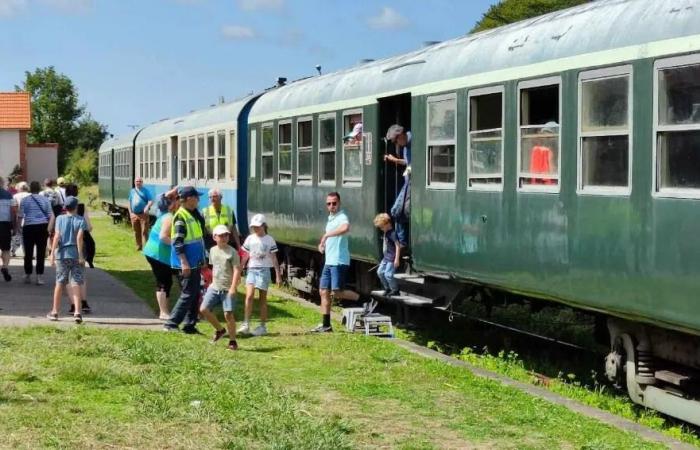France Bleu Cotentin: The Cotentin tourist train has become an emblem of the Cote des Isles. Can you present it to us already?
Philippe Crinon, Secretary of Tourism and Channel Railway: This train connects Barneville-Carteret to Portbail. It was created in 1990. We have several locomotives. The main one dates from 1955. And the passenger cars are from 1960. The car bases date back to the Prussian era. At the time, they were made of wood. They were perfectly recovered at the end of the 1914-18 war, and they were metallized and extended in the 1960s. It is material that is old, but we manage to maintain it without problem because it is mainly of labor. We have volunteers who, during the winter, roll up their sleeves, put themselves in the shed and in the pit to grease, check, adjust all this equipment so that it can have a good season. We also have a small shunter which is more recent, from 1965. It is he who is working on the trains at the moment since the trains are a little less full on Sundays than in high season. And then we also have a small handcar which is a construction locomotive which allows us to send and bring around fifteen passengers when we don’t have enough people to make a full train or on privatized trains, like an aperitif family, bachelor or bachelorette party, etc.
Will 2025 be the last season for the Cotentin Tourist Train?
So unfortunately, we fear him. If we look at the past years, we have invested a lot of money from our own funds to try to bring the track up to standard, since it is this which is mainly causing the problem at the moment. We clearly can’t do it. We have roughly 14,000 sleepers between Carteret station and Portbail station. We are in the process of changing sleepers that date from 1960. But we cannot catch up with the delay that was incurred in previous decades to bring the track back to level.
The paradox is that this train has broken attendance records…
Of course. This is what makes us all the sadder, is that the tourist train is working exceptionally well: 11,473 passengers for the 2023-2024 season. There are storms of smiles as we get off the train. People are delighted, enchanted, both tourists and locals. People are waiting, hearing the train horn saying that, the train is coming, spring is here, everyone wants to get on the train. We refuse people on market trains in the summer. And unfortunately, for obvious safety reasons, we will have to stop if we cannot restore this road.
What does maintaining this road represent in concrete terms?
The route is very old: it dates from the end of the 19th century. The sleepers are made of wood, the rails are models that are no longer found today. We still manage to find oars by searching, we manage to buy sleepers. But their implementation requires the use of companies specializing in railways, which necessarily move important and therefore costly equipment for us using our own funds. We would be able to change 300 to 400 sleepers necessary for the line to be maintained. A sleeper has a lifespan of approximately sixty years. And if we want to renew them every sixty years, we have to change 300 to 400 per year. When the train was not as busy as today, the association did not have the means to change them. That’s where the delay came from. If you add to this the covid years and others which have increased this delay, we find ourselves in a complex situation. We must add the fact that we have two structures that we cross: the Pont du Tôt, which spans the Gerfleur in Barneville, and the Pont de la Rocque in Portbail. These structures will need work in the next two years, following the audit we carried out. It provides for between 150 and 250,000 euros in costs per bridge.
The bill is too heavy…
We have a railway works company who have worked with for several years, and who love to come and work on the Tourist Train because they find the line nice. But the audit carried out highlights the need to change 2,715 sleepers, or 407,000 euros. A little over two years ago, we carried out a major action to save the season: we had the help of the municipalities we passed through, the department and the Cotentin urban community. But beyond that, all the work carried out is on our own funds. So we invest between 40 and 50,000 euros every year, which is the direct reinvestment of the entire season’s results. By even mortgaging the coming season since we can only immobilize the track from January to March. We anticipate recipes for the coming season. And thanks to the flexibility of companies who agree to defer invoices or collections, we manage, year after year, to change 300 to 400 sleepers per year.
In a complicated context in terms of budgets, have you launched an appeal to local authorities?
So of course, we called on all the local authorities. So, you know that now, funding is organized according to skills. The Manche department does not have tourism expertise, and therefore cannot invest in tourism action such as ours. The Cotentin Agglomeration has tourism competence, but does not want to invest in equipment which is our route, which still belongs to the SNCF. So it is not going to invest public money in a structure which belongs to a third party. And so we find ourselves completely stuck at this level. And the region we contacted recently did not respond. So we’re completely stuck. We made requests to the Community Life Development Fund, we contacted the largest companies in the Manche department. We even have an online prize pool. We really did everything we could to support us. Everyone completely agrees that the train must continue. It is an absolute necessity. We have the fifth largest ticket generator at tourist offices after Manche Îles Express, after the Cap Cotentin trains, the Cité de la Mer and Tatihou Island. So we are the fifth generator in terms of ticketing, but we cannot manage to surface because we cannot bring this road up to standard, which is necessary to be able to travel safely.
For the moment, are you renting the line from the SNCF?
It belongs to Réseau SNCF. It costs us 3,000 euros per year, but it is up to us to maintain it. SNCF has wanted to sell it for twenty years: at the beginning, it wanted 650,000 euros. Today it has reached 250,000, but no one has these means, at least not the association. So we made a proposal for recovery at a symbolic euro, as has been done in many other departments. But for the moment, we have received a total refusal from the owner, although this is what could unravel the problem and since a priori we have received favorable signals saying: if in the future; the line belonged to you, we could at that point inject money, but we are not going to do it in a property that does not belong to either the association or a local community.
Funding is the first problem. But not the only one?
Once we have upgraded the track, we will need to find additional volunteers. Because to make a train, you need a driver, a shunter, a conductor, an assistant conductor and then a bar manager, a conductor. There are quite a few things. But what really gets stuck is budgetary. To upgrade the sail, we would have to manage to upgrade the 2,700 sleepers that I spoke to you about every two years.






